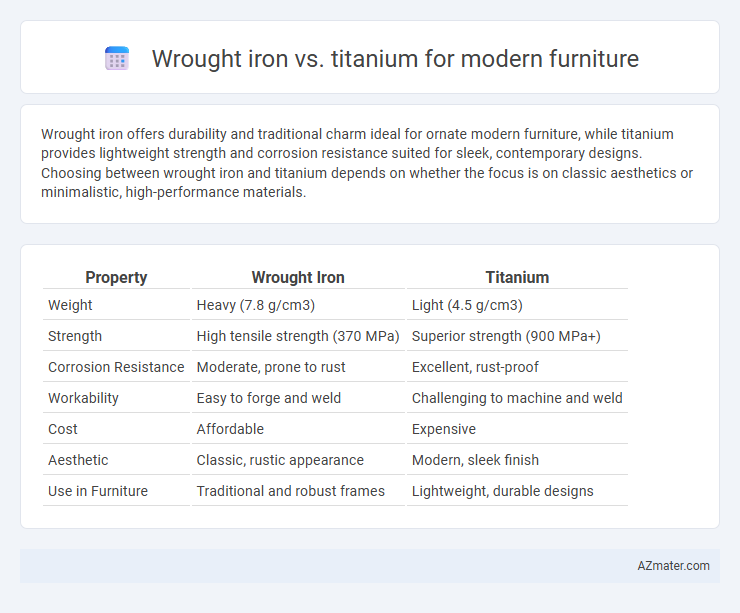Wrought iron offers durability and traditional charm ideal for ornate modern furniture, while titanium provides lightweight strength and corrosion resistance suited for sleek, contemporary designs. Choosing between wrought iron and titanium depends on whether the focus is on classic aesthetics or minimalistic, high-performance materials.
Table of Comparison
| Property | Wrought Iron | Titanium |
|---|---|---|
| Weight | Heavy (7.8 g/cm3) | Light (4.5 g/cm3) |
| Strength | High tensile strength (370 MPa) | Superior strength (900 MPa+) |
| Corrosion Resistance | Moderate, prone to rust | Excellent, rust-proof |
| Workability | Easy to forge and weld | Challenging to machine and weld |
| Cost | Affordable | Expensive |
| Aesthetic | Classic, rustic appearance | Modern, sleek finish |
| Use in Furniture | Traditional and robust frames | Lightweight, durable designs |
Introduction: Wrought Iron vs Titanium in Modern Furniture
Wrought iron and titanium represent two distinct materials widely used in modern furniture design, each offering unique properties that affect durability, weight, and aesthetic appeal. Wrought iron is prized for its classic, robust structure and intricate detailing, while titanium stands out for its exceptional strength-to-weight ratio and corrosion resistance. Understanding these differences is crucial for designers and consumers seeking furniture that balances style with functionality and longevity.
Material Composition and Characteristics
Wrought iron, composed primarily of iron with low carbon content, offers exceptional malleability and corrosion resistance ideal for ornate, heavy-duty modern furniture frames. Titanium, an alloy containing mainly titanium with elements like aluminum and vanadium, provides superior strength-to-weight ratio, corrosion resistance, and durability, making it suitable for lightweight and long-lasting contemporary furniture designs. While wrought iron emphasizes robustness and classic appeal, titanium excels in modern applications requiring both strength and minimal weight.
Strength and Durability Comparison
Wrought iron offers exceptional strength and durability, providing a robust and heavy framework ideal for long-lasting furniture pieces. Titanium, while lighter, surpasses wrought iron in tensile strength and corrosion resistance, making it highly durable in diverse environmental conditions. The choice between wrought iron and titanium depends on the desired balance between weight, strength, and longevity in modern furniture design.
Weight and Handling Differences
Wrought iron is significantly heavier than titanium, impacting the ease of handling and relocation of modern furniture pieces. Titanium's lightweight properties allow for more versatile and ergonomic designs, making it preferred in settings where mobility and comfort are prioritized. The dense, robust nature of wrought iron offers superior stability but requires more effort during installation and movement.
Aesthetic Appeal and Design Flexibility
Wrought iron offers a classic, vintage aesthetic with intricate patterns and a heavy, durable feel that enhances traditional and rustic furniture designs. Titanium provides a sleek, modern look with its smooth surface and metallic sheen, allowing for innovative shapes and lightweight structures that push the boundaries of contemporary furniture design. The design flexibility of titanium surpasses wrought iron due to its corrosion resistance and malleability, enabling more complex, minimalist, and futuristic styles without compromising strength.
Corrosion Resistance and Maintenance
Titanium offers superior corrosion resistance compared to wrought iron, as it naturally forms a protective oxide layer that prevents rust and degradation even in humid or salty environments. Wrought iron requires regular maintenance, such as applying protective coatings and anti-rust treatments, to prevent oxidation and prolong its lifespan in modern furniture applications. Choosing titanium reduces maintenance frequency and ensures long-lasting durability, making it ideal for both indoor and outdoor furniture exposed to varying environmental conditions.
Sustainability and Environmental Impact
Wrought iron, known for its durability and recyclability, has a higher carbon footprint due to energy-intensive smelting and forging processes, whereas titanium offers superior strength-to-weight ratio with a lower environmental impact from corrosion resistance reducing the need for frequent replacements. The sustainability of wrought iron depends on efficient recycling practices, while titanium's extraction and processing involve complex mining with potential ecological concerns. Choosing between them for modern furniture requires balancing lifecycle emissions, material longevity, and end-of-life recyclability to minimize environmental impact.
Cost Analysis: Wrought Iron vs Titanium
Wrought iron furniture typically costs significantly less than titanium due to the abundance and lower processing expenses of iron. Titanium's high cost is driven by its premium material properties, including corrosion resistance and lightweight strength, paired with complex manufacturing requirements. For budget-conscious buyers, wrought iron offers durable and affordable options, whereas titanium suits high-end designs demanding exceptional performance despite the higher investment.
Applications in Contemporary Furniture Design
Wrought iron offers durability and classic aesthetic appeal, making it ideal for outdoor and rustic-themed contemporary furniture such as garden benches and decorative railings. Titanium provides exceptional strength-to-weight ratio and corrosion resistance, perfect for sleek, minimalist furniture designs requiring lightweight yet sturdy frames. Both materials enhance modern furniture by combining structural integrity with unique visual characteristics tailored to different design philosophies.
Choosing the Right Material for Modern Furniture
Wrought iron offers durability, a classic aesthetic, and is ideal for heavy-duty modern furniture pieces, while titanium provides lightweight strength, corrosion resistance, and a sleek, contemporary look. Choosing the right material depends on factors like weight requirements, environmental exposure, and design preferences. Titanium suits minimalist, high-end designs needing portability, whereas wrought iron excels in robust, outdoor or industrial-style furniture.

Infographic: Wrought iron vs Titanium for Modern furniture
 azmater.com
azmater.com